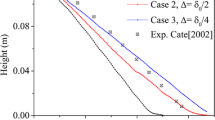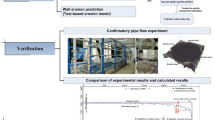Abstract
The plugging phenomena of particle–fluid two-phase flow systems are omnipresent in industrial processes, usually causing negative consequences. To study the mechanism of bridging in the bend rectangle channels, based on the theory of solid–liquid flow, a resolved Computational Fluid Dynamics and Discrete Element Method (CFD–DEM) is proposed for simulating the dynamic bridging process of particles. The resolved CFD–DEM model is verified by theoretical formula and experimental results from the literature, and its fitness increases the credibility and applicability. The criterion of critical particle concentration is also developed to quantitatively evaluate the impacts of particle density, channel geometry and fluid dynamic viscosity on bridging capacity, and several conclusions are derived under varied parameters. The dominant influencing factor on the plugging efficiency shifts from the particle velocity to the drag force acting on the particle with the increase in the dynamic viscosity. It is shown that the method is used intuitively and accurately for describing the hydrodynamic bridging phenomena.






















Similar content being viewed by others
References
Mondal S (2013) Flow of particulate suspensions through constrictions : multi-particle effects. Dissertation, The University of Texas at Austin
Liu AJ, Nagel SR (1998) Jamming is not just cool any more. Nature 396:21–22. https://doi.org/10.1038/23819
Alsaba MT, Nygaard R, Hareland G, Contreras O (2014) Review of lost circulation materials and treatments with an updated classification. In: American Association of Drilling Engineers (AADE) National Technical Conference and Exhibition, Houston, Texas, USA, pp 15–16
Lavrov A (2016) Lost circulation: mechanisms and solutions. Gulf Professional Publishing, Oxford
Sharp KV, Adrian RJ (2001) Shear-induced arching of particle-laden flows in microtubes. In: 2001 ASME international mechanical engineering congress and exposition, New York, USA, pp 553–557
Sharp KV (2002) Experimental investigation of liquid and particle-laden flows in microtubes. Dissertation, University of Illinois at Urbana-Champaign
Sharp KV, Adrian RJ (2005) On flow-blocking particle structures in microtubes. Microfluid Nanofluid 1:376–380. https://doi.org/10.1007/s10404-005-0043-x
Kaushal DR, Tomita Y (2003) Comparative study of pressure drop in multisized particulate slurry flow through pipe and rectangular duct. Int J Multiph Flow 29:1473–1487. https://doi.org/10.1016/S0301-9322(03)00125-3
Valdes JR, Santamarina JC (2006) Particle clogging in radial flow: microscale mechanisms. SPE J 11:193–198. https://doi.org/10.2118/88819-PA
Dai J, Grace JR (2010) Blockage of constrictions by particles in fluid–solid transport. Int J Multiph Flow 36:78–87. https://doi.org/10.1016/j.ijmultiphaseflow.2009.08.001
Lafond PG, Gilmer MW, Koh CA et al (2013) Orifice jamming of fluid-driven granular flow. Phys Rev E 87:042204. https://doi.org/10.1103/PhysRevE.87.042204
Guariguata A, Pascall MA, Gilmer MW et al (2012) Jamming of particles in a two-dimensional fluid-driven flow. Phys Rev E 86:061311. https://doi.org/10.1103/PhysRevE.86.061311
Jeennakorn M, Nygaard R, Nes O-M, Saasen A (2017) Testing conditions make a difference when testing LCM. J Nat Gas Sci Eng 46:375–386. https://doi.org/10.1016/j.jngse.2017.08.003
Mondal S, Wu C-H, Sharma MM (2016) Coupled CFD–DEM simulation of hydrodynamic bridging at constrictions. Int J Multiph Flow 84:245–263. https://doi.org/10.1016/j.ijmultiphaseflow.2016.05.001
Yang X, Chen S, Shi Y et al (2019) CFD and DEM modelling of particles plugging in shale pores. Energy 174:1026–1038. https://doi.org/10.1016/j.energy.2019.03.050
Zhu B, Tang H, Wang X et al (2020) Coupled CFD–DEM simulation of granular LCM bridging in a fracture. Part Sci Technol 38:371–380. https://doi.org/10.1080/02726351.2018.1547341
Sun H, Xu S, Pan X et al (2019) Investigating the jamming of particles in a three-dimensional fluid-driven flow via coupled CFD–DEM simulations. Int J Multiph Flow 114:140–153. https://doi.org/10.1016/j.ijmultiphaseflow.2019.01.017
Anderson TB, Jackson R (1968) Fluid mechanical description of fluidized beds. Stability of state of uniform fluidization. Ind Eng Chem Fund 7:12–21. https://doi.org/10.1021/i160025a003
Tsuji Y, Kawaguchi T, Tanaka T (1993) Discrete particle simulation of two-dimensional fluidized bed. Powder Technol 77:79–87. https://doi.org/10.1016/0032-5910(93)85010-7
Liu D, Bu C, Chen X (2013) Development and test of CFD–DEM model for complex geometry: a coupling algorithm for Fluent and DEM. Comput Chem Eng 58:260–268. https://doi.org/10.1016/j.compchemeng.2013.07.006
Zhou ZY, Kuang SB, Chu KW, Yu AB (2010) Discrete particle simulation of particle–fluid flow: model formulations and their applicability. J Fluid Mech 661:482–510. https://doi.org/10.1017/S002211201000306X
Tenneti S, Subramaniam S (2014) Particle-resolved direct numerical simulation for gas-solid flow model development. Annu Rev Fluid Mech 46:199–230. https://doi.org/10.1146/annurev-fluid-010313-141344
Cheng K, Wang Y, Yang Q (2018) A semi-resolved CFD–DEM model for seepage-induced fine particle migration in gap-graded soils. Comput Geotech 100:30–51. https://doi.org/10.1016/j.compgeo.2018.04.004
Casagrande MVS, Alves JLD, Silva CE et al (2017) A hybrid FEM-DEM approach to the simulation of fluid flow laden with many particles. Comput Part Mech 4:213–227. https://doi.org/10.1007/s40571-016-0102-y
Griffith BE, Patankar NA (2020) Immersed methods for fluid–structure interaction. Annu Rev Fluid Mech 52:421–448. https://doi.org/10.1146/annurev-fluid-010719-060228
Kloss C, Goniva C, Hager A et al (2012) Models, algorithms and validation for opensource DEM and CFD–DEM. Prog Comput Fluid Dyn 12:140–152. https://doi.org/10.1504/PCFD.2012.047457
Garg R, Tenneti S, Yusuf JM, Subramaniam S (2011) Direct numerical simulation of gas-solids flow based on the immersed boundary method. In: Pannala S, Syamlal M, O’Brien TJ (eds) Computational gas-solids flows and reacting systems: theory, methods and practice. Engineering Science Reference, New York, pp 245–276. https://doi.org/10.4018/978-1-61520-651-3.ch008
Jabeen S, Usman K, Walayat K (2020) Numerical investigations for a chain of particles settling in a channel. Comput Part Mech 7:615–627. https://doi.org/10.1007/s40571-019-00289-2
Goniva C, Kloss C, Hager A et al (2011) A multi-purpose open source CFD–DEM approach. In: 8th international conference on CFD in oil & gas, metallurgical and process industries, SINTEF/NTNU, Trondheim, Norway, pp 21–23
OpenFOAM (2013) OpenFOAM user guide. https://openfoam.org/
Cundall PA, Strack ODL (1979) A discrete numerical model for granular assemblies. Géotechnique 29:47–65. https://doi.org/10.1680/geot.1979.29.1.47
Anderson TB, Jackson R (1967) Fluid mechanical description of fluidized beds. Equations of motion. Ind Eng Chem Fund 6:527–539. https://doi.org/10.1021/i160024a007
Shirgaonkar AA, MacIver MA, Patankar NA (2009) A new mathematical formulation and fast algorithm for fully resolved simulation of self-propulsion. J Comput Phys 228:2366–2390. https://doi.org/10.1016/j.jcp.2008.12.006
Hager A, Kloss C, Pirker S, Goniva C (2014) Parallel resolved open source CFD–DEM: method, validation and application. J Comput Multiph Flow 6:13–27. https://doi.org/10.1260/1757-482X.6.1.13
Hager A (2014) CFD–DEM on multiple scales-an extensive investigation of particle-fluid interactions. Johannes Kepler University Linz, Linz
Brilliantov NV, Spahn F, Hertzsch J-M, Pöschel T (1996) Model for collisions in granular gases. Phys Rev E 53:5382–5392. https://doi.org/10.1103/PhysRevE.53.5382
Silbert LE, Ertaş D, Grest GS et al (2001) Granular flow down an inclined plane: Bagnold scaling and rheology. Phys Rev E 64:051302. https://doi.org/10.1103/PhysRevE.64.051302
Zhang HP, Makse HA (2005) Jamming transition in emulsions and granular materials. Phys Rev E 72:011301. https://doi.org/10.1103/PhysRevE.72.011301
Ertaş D, Grest GS, Halsey TC et al (2001) Gravity-driven dense granular flows. EPL Europhys Lett 56:214. https://doi.org/10.1209/epl/i2001-00508-7
Cheng K, Wang Y, Yang Q et al (2017) Determination of microscopic parameters of quartz sand through tri-axial test using the discrete element method. Comput Geotech 92:22–40. https://doi.org/10.1016/j.compgeo.2017.07.017
Fidleris V, Whitmore RL (1961) Experimental determination of the wall effect for spheres falling axially in cylindrical vessels. Br J Appl Phys 12:490–494. https://doi.org/10.1088/0508-3443/12/9/311
Apte SV, Martin M, Patankar NA (2009) A numerical method for fully resolved simulation (FRS) of rigid particle–flow interactions in complex flows. J Comput Phys 228:2712–2738. https://doi.org/10.1016/j.jcp.2008.11.034
Kajishima T, Takiguchi S, Hamasaki H, Miyake Y (2001) Turbulence structure of particle-laden flow in a vertical plane channel due to vortex shedding. JSME Int J B-Fluid Trans 44:526–535. https://doi.org/10.1299/jsmeb.44.526
Dyke MV (1970) Extension of Goldstein’s series for the Oseen drag of a sphere. J Fluid Mech 44:365–372. https://doi.org/10.1017/S0022112070001878
Turton R, Levenspiel O (1986) A short note on the drag correlation for spheres. Powder Technol 47:83–86. https://doi.org/10.1016/0032-5910(86)80012-2
Brown PP, Lawler DF (2003) Sphere drag and settling velocity revisited. J Environ Eng 129:222–231. https://doi.org/10.1061/(ASCE)0733-9372(2003)129:3(222)
Ergun S (1952) Fluid flow through packed columns. Chem Eng Prog 48:89–94
Xu C, Kang Y, Chen F, You Z (2017) Analytical model of plugging zone strength for drill-in fluid loss control and formation damage prevention in fractured tight reservoir. J Pet Sci Eng 149:686–700. https://doi.org/10.1016/j.petrol.2016.10.069
Acknowledgements
The authors gratefully acknowledge the financial support of Strategic Priority Research Program (A) of the Chinese Academy of Sciences (Grant No. XDA22040305) and Hainan Provincial Natural Science Foundation of China (Grant No. 520QN229).
Author information
Authors and Affiliations
Corresponding author
Ethics declarations
Conflict of interest
The authors declare that they have no conflict of interest.
Additional information
Technical Editor: Monica Carvalho.
Publisher's Note
Springer Nature remains neutral with regard to jurisdictional claims in published maps and institutional affiliations.
Rights and permissions
About this article
Cite this article
**ong, H., Chen, Y., Chen, M. et al. Resolved CFD–DEM simulation on hydrodynamic bridging in a bend rectangle channel. J Braz. Soc. Mech. Sci. Eng. 43, 362 (2021). https://doi.org/10.1007/s40430-021-03065-7
Received:
Accepted:
Published:
DOI: https://doi.org/10.1007/s40430-021-03065-7




